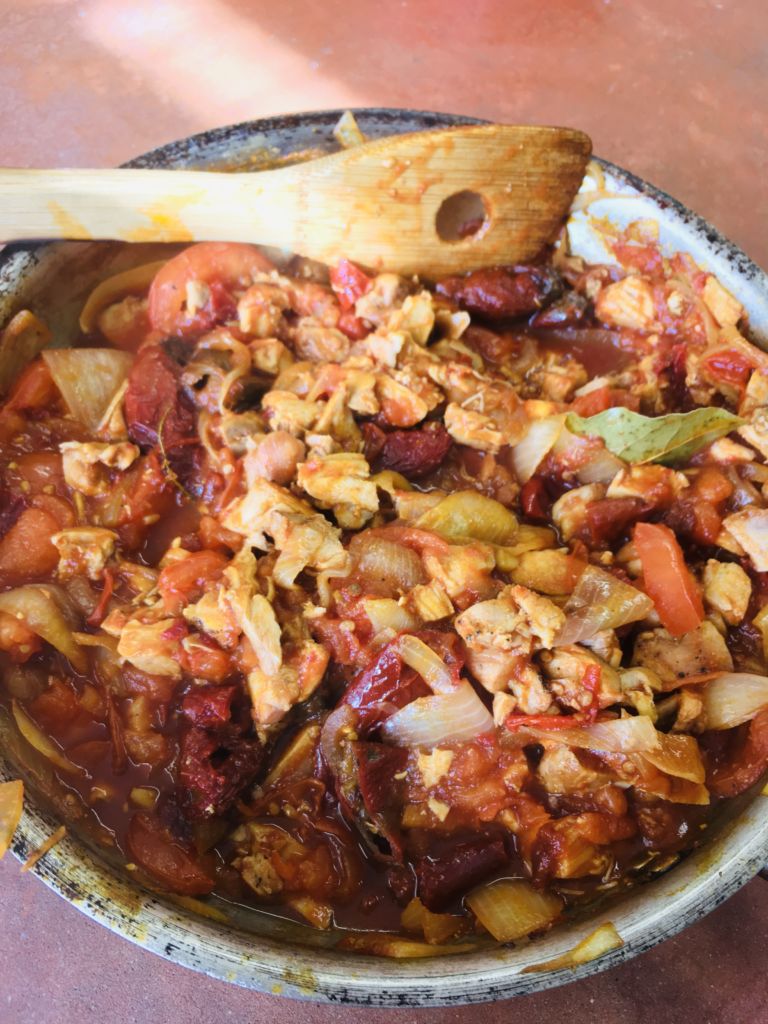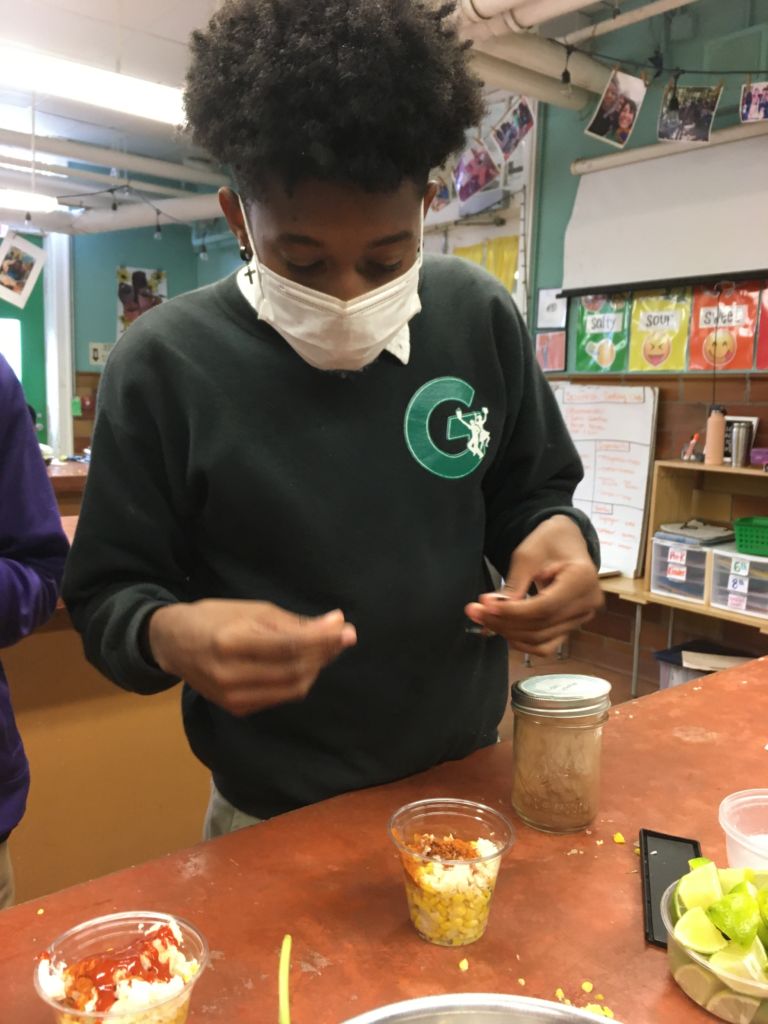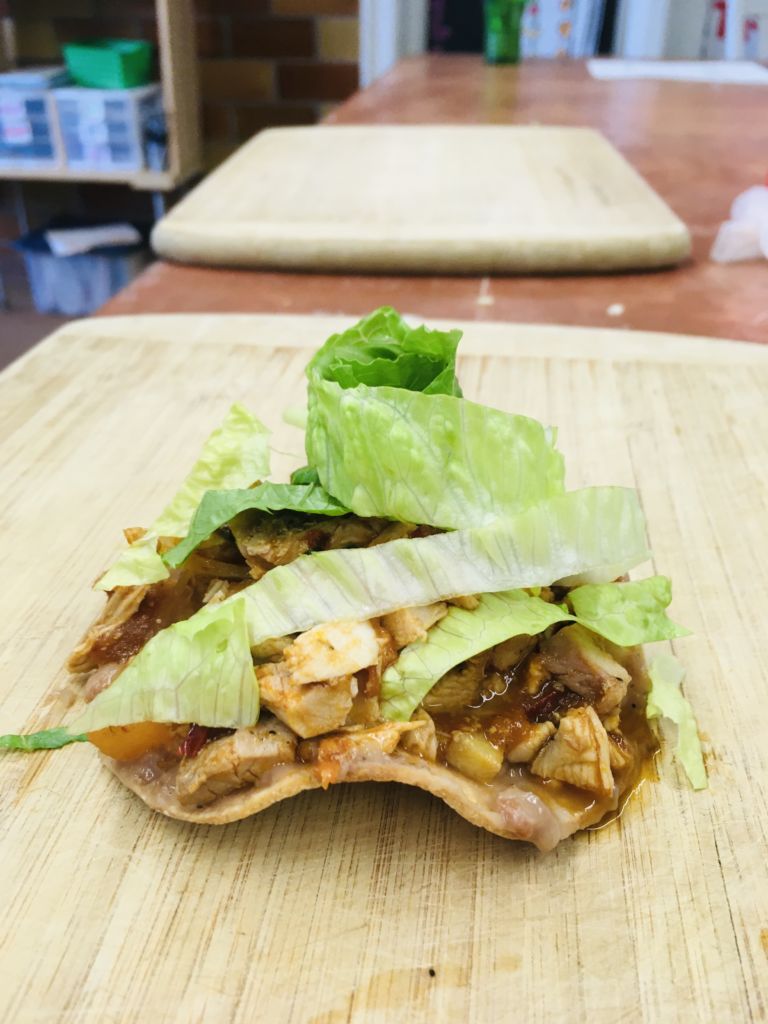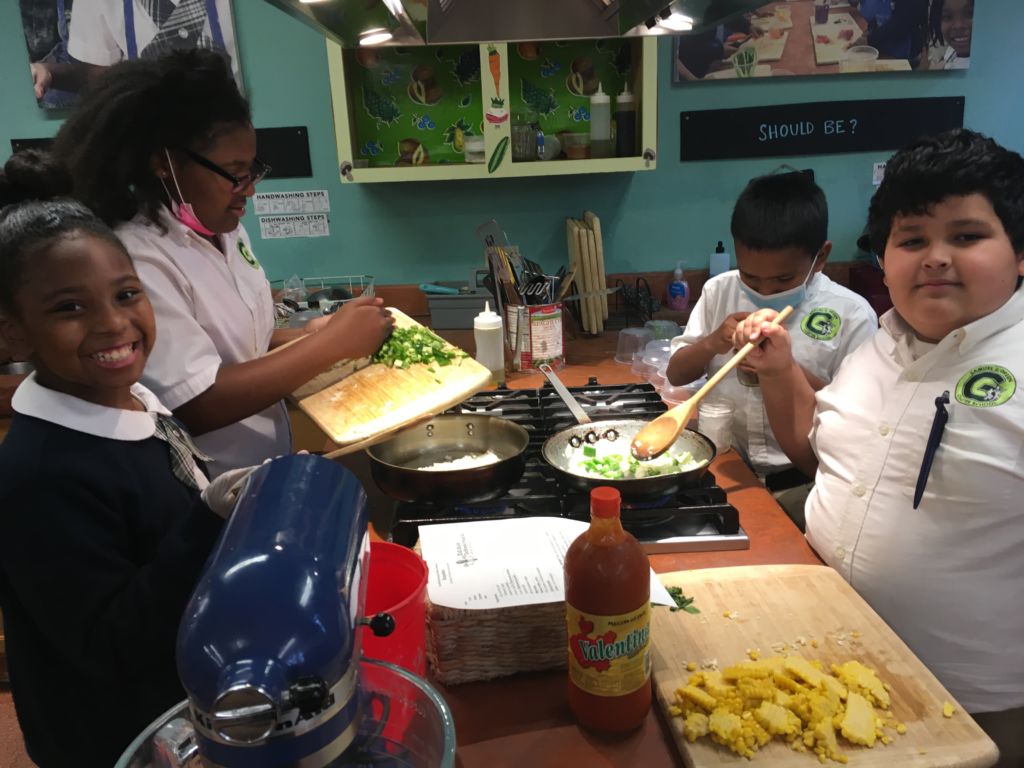A typical Wednesday in the kitchen at Samuel J. Green is, well, anything but typical. At 7:15am a handful of middle school students are already lit up with excitement as they file into school. Wide eyed and bushy tailed, a few students pop into the kitchen. “What are we making today?” is their first question of the day. It’s Spanish Cooking Club day after all.
At 11am, a gaggle of 5th graders stream into the kitchen with lunches in tow. Chef Sasha heads upstairs to get the 7th and 8th graders. For these middle schoolers, Wednesdays provide another incentive to stay on top of their game academically. Only after they finish their assignments can they head down to the kitchen for Spanish Cooking Club.
By the time everyone makes it in, the kitchen is buzzing with 16 middle schoolers. There is a table for each grade: 5th, 7th and 8th. Clap clap, clap-clap-clap. The chefs begin with a call to attention, reminding students that being in the kitchen outside of class time is a privilege. By the looks on their faces and their eager bodies humming with anticipation, the students know it too.
After a lively icebreaker, teachers direct students to their recipes for the day, but this time there is a special challenge. In Spanish Cooking Club, not only are the recipes from a different country each week as the club travels gastronomically through Latin America (starting in Mexico and ending in Argentina by the end of the trimester), but the recipe must first be translated. Upon first glance the recipe is easily separated into sections for “Ingredients” and “Directions.” But take a closer look, and bolded words that are new to some students like frijoles, tazón, and picado pop out.
Teachers challenge students to recall the words in Spanish they learned the week before. The chefs draw students’ attention to a white board filled with key terms in Spanish, defined and separated into thematic categories such as Tools, Ingredients, Verbs, and Prep. Students look up often to use this resource for extra help as they translate.
After the first 30 seconds of solo work time, students turn to their partners to decipher the recipe. Chiles chipotles? One student proudly explains to his group that the order of descriptive words are flipped in Spanish. Students’ faces light up as they begin to understand. “Sal y pimienta, salt and pepper!” exclaims one student, proudly sharing what she remembers. Another student raises their hand to share an alternative word they use at home for picado, or chop. The kitchen hums, everyone hurriedly translating so they can get to the much-anticipated cooking.
The ingredients are brought out, and the class becomes something between a choreographed dance and controlled chaos; some students work together to decipher recipes and prep ingredients, while others work diligently at the stove. Chef teachers float between groups to answer questions and reinforce highlighted Spanish vocabulary. “You’re gonna need the sarten and the cebolla,” Chef Megan reminds the 5th graders.
Twenty quick minutes later, the groups plate their tostadas de tinga before hurrying off to recess or back to class. The smiles and look of pride on the students’ faces tell the whole story.
For the students in Spanish Cooking Club, the 50 quick minutes together in the kitchen transforms their day. Overcoming a challenge – whether that be deciphering a recipe, learning a new language, or sharing knowledge with peers – pulls students out of their comfort zone and leaves them proud of the tangible (and delicious) result that their learning and teamwork have produced. Even the quietest students are excited to share what they made and explain to their teachers and classmates how they prepared it.
When asked how Spanish Cooking Club came about, Chef Sasha says, “We saw the leadership potential in so many of our bilingual and Spanish-speaking students. At the same time, we saw a desire in other students to learn Spanish. So why not bring the two together?”
Edible Schoolyard’s chef teachers designed Spanish Cooking Club to create space for students’ identities, language, and food culture to be seen and celebrated in ways that are not typically possible at school. Exploring various dishes and cultures throughout Latin America affirms students’ diverse experiences and backgrounds, while simultaneously increasing students’ global perspectives and cultural awareness. Spanish Cooking Club also gives students the opportunity to build relationships with one another while gaining teamwork and communication skills. Learning from one another not only reinforces connections but celebrates differences through an asset-based lens, as each student offers a unique contribution to their team.
A few minutes after the kitchen has been cleared, a couple of students from the club lead a group of teachers and school leaders into the kitchen. “We had to get some for everyone!” they exclaim. Students eagerly assemble tostadas for the adults, moving in practiced unison. While carefuly garnishing each plate with queso and crema, the students describe each ingredient and technique used, relying on each other’s memories and experiences to recount the recipe in detail. The chefs stand back, observing the scene and looking for clues that this new endeavor is leading to the student outcomes they’d envisioned. The curious and excited crowd and the students’ skillful hands and proud smiles say it all.
el Club de Cocina en Español
Un miércoles típico en la cocina de Samuel J. Green es, pues, cualquier cosa menos típica. A las 7:15am algunos estudiantes de escuela secundaria ya están iluminados con emoción cuando llegan a la escuela. Con los ojos muy abiertos y con mucha energía, algunos estudiantes van a la cocina. “¿Qué vamos a hacer hoy?” Es su primera pregunta del día. ¡Es el día del Club de Cocina en Español!
A las 11am, un grupo de estudiantes de 5to grado vienen a la cocina con sus almuerzos.
Chef Sasha corre arriba para recoger a los estudiantes de 7to y 8avo grado. Para estos estudiantes de secundaria, los miércoles proveen otro incentivo para mantenerse al día académicamente. Sólo después de que han terminado sus tareas pueden ir a la cocina para el Club de Cocina en Español.
Cuando todos llegan, la cocina está animada con 16 estudiantes. Hay una mesa para cada nivel de grado: 5to, 7to, y 8avo. Clap clap, clap-clap-clap. Los chefs empiezan con una llamada de atención, recordando a los estudiantes que estar en la cocina fuera de la hora de clase es un privilegio. Por las miradas en sus caras y sus cuerpos entusiastas animados con anticipación, los estudiantes también lo saben.
Después de una charla para romper el hielo, los maestros dirigen a los estudiantes a sus recetas para el día, pero esta vez hay un reto especial. En el Club de Cocina en Español, no solo se hacen las recetas de un país diferente cada semana mientras el club viaja gastronómicamente a través de América Latina (empezando en México y terminando en Argentina por el fin del trimestre), pero la receta tiene que ser traducida primero. A primera vista, la receta está separada fácilmente en secciones para “Ingredientes” y “Indicaciones.” Pero eché otra mirada, y palabras negritas que son nuevas a algunas estudiantes como frijoles, tazón, y picado sobresalen.
Los maestros desafían a los estudiantes a recordar las palabras en español que aprendieron la semana anterior. Dirigen la atención de los estudiantes a una pizarra llena de palabras claves en español, definidas y divididas en categorías temáticas como Herramientas, Ingredientes, Verbos, y Preparación. Los estudiantes levantan la vista frecuentemente para usar ese recurso para ayuda extra mientras traducen.
Después de los primeros 30 segundos de trabajo independiente, los estudiantes giran a sus compañeros para descifrar la receta. ¿Chiles chipotles? Un estudiantes explica orgullosamente que la orden de palabras descriptivas está al revés en español. Las caras de los estudiantes se iluminan mientras empiezan a entender. “Sal y pimienta, salt and pepper!” exclama un estudiante, compartiendo orgullosamente lo que recuerde. Otra estudiante levanta la mano para compartir una palabra diferente que usan en casa para picar. La cocina se anima, todos traduciendo rápidamente para que puedan cocinar ya.
Traigan los ingredientes, y la clase se convierte en algo entre un baile coreografiado y caos controlado; algunos estudiantes trabajan juntos para descifrar recetas y preparar ingredientes mientras otros trabajan diligentemente en la estufa. Maestros ayudan con varios grupos para contestar preguntas y reforzar vocabulario en español resaltado. “Van a necesitar la sartén y la cebolla,” Chef Megan recuerde a los estudiantes.
Veinte minutos más tarde, los grupos ponen sus tostadas de tinga en los platos antes de volver a recreo o a clase. Las sonrisas y miradas de orgullo en las caras de los estudiantes cuentan la historia completa.
Para los estudiantes en el Club de Cocina en Español, los 50 minutos juntos en la cocina transforma su día. Superando un reto – si sea descifrar una receta, aprender un nuevo idioma, o compartiendo su sabiduría con amigos – le tira a los estudiantes de su zona de confort y les deja orgullosos del resultado tangible (y delicioso) que su aprendizaje y trabajo en equipo ha producido. Aún los estudiantes más tímidos están emocionados de compartir lo que hicieron y explicar a sus maestros y compañeros de clase cómo lo hicieron.
Cuando le pregunta cómo empezó el Club de Cocina en Español, Chef Sasha dice, “Vimos el potencial de liderazgo en tantos de nuestros estudiantes bilingües e hispanohablantes. A la vez, vimos un deseo en otros estudiantes de aprender español. ¿Entonces por qué no unir a los dos?”
Los maestros-chefs de Patio Comestible diseñaron al Club de Cocina en Español para crear espacio para las identidades, idiomas, y cultura de comida de los estudiantes para que se las puedan celebrar y ver de maneras que típicamente no son posibles en escuela. Explorando platos y culturas diferentes a través de América Latina afirma las experiencias e historias diversas de los estudiantes, mientras simultáneamente aumentado las perspectivas globales y concientización cultural de los estudiantes. El Club de Cocina en Español también les da a los estudiantes la oportunidad de fortalecer amistades entre ellos mientras que ganan habilidades de comunicación y trabajo en equipo. Aprender de uno al otro no solo refuerza conexiones pero también celebra diferencias de una vista basada en los valores, como que cada estudiantes ofrece una contribución única al equipo.
Algunos minutos después de que han limpiado la cocina, algunos estudiantes del club llevan un grupo de maestros y líderes escolares a la cocina. “Tuvimos que conseguir un poco para todos!” exclaman. Los estudiantes preparan tostadas para los adultos, moviéndose en simultaneidad practicada. Mientras cuidadosamente decoran cada plato con queso y crema, los estudiantes describen cada ingrediente y técnica usada, dependiendo de las memorias y experiencias de cada uno para narrar la receta en detalle. Los chefs se mantienen alejados, observando la escena y buscando pistas que este nuevo esfuerzo está guiando a los resultados en los estudiantes que imaginaron. La multitud curiosa y emocionada y las manos habilidosos y sonrisas orgullosas de cada estudiantes les dice todo.






